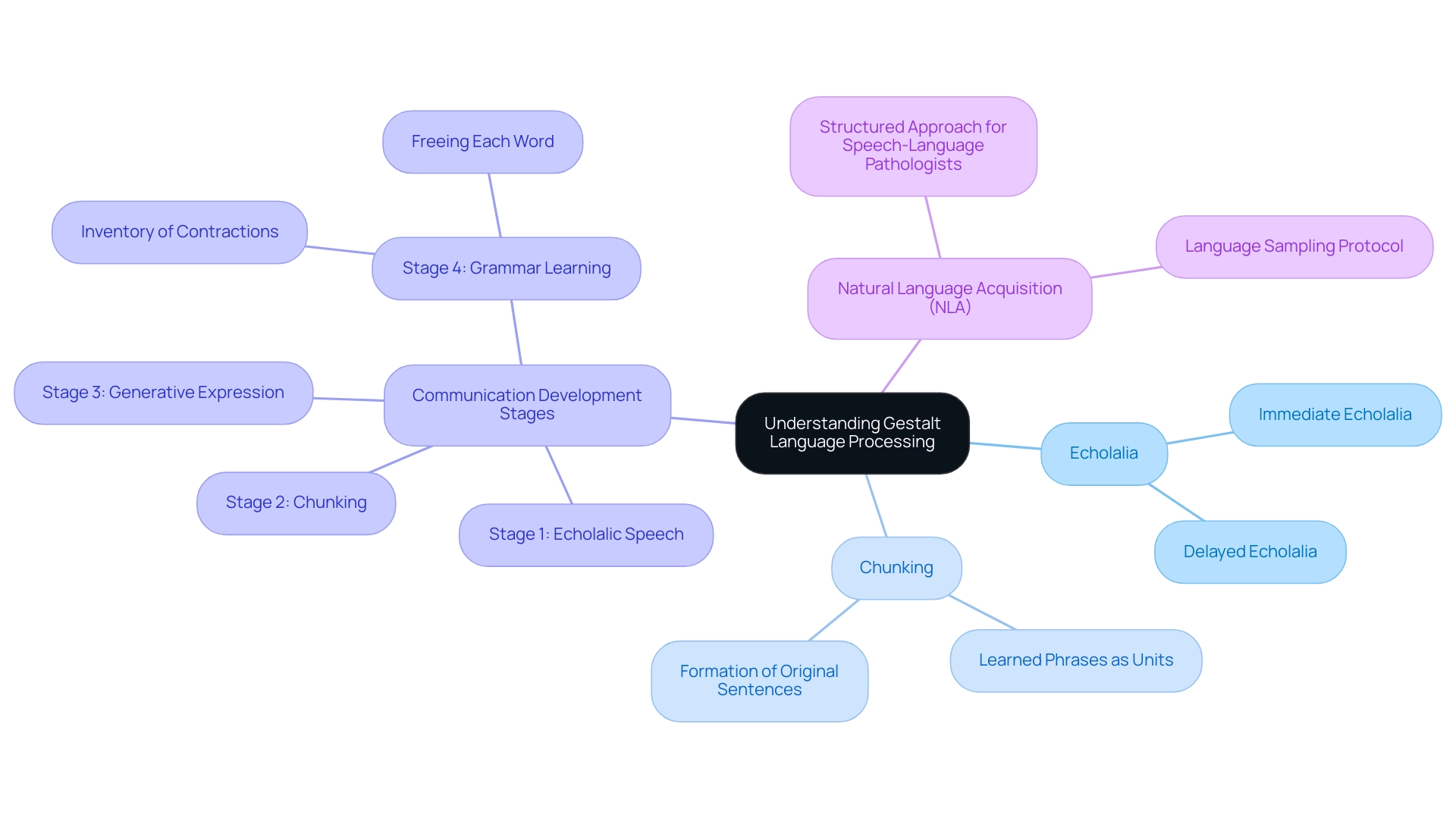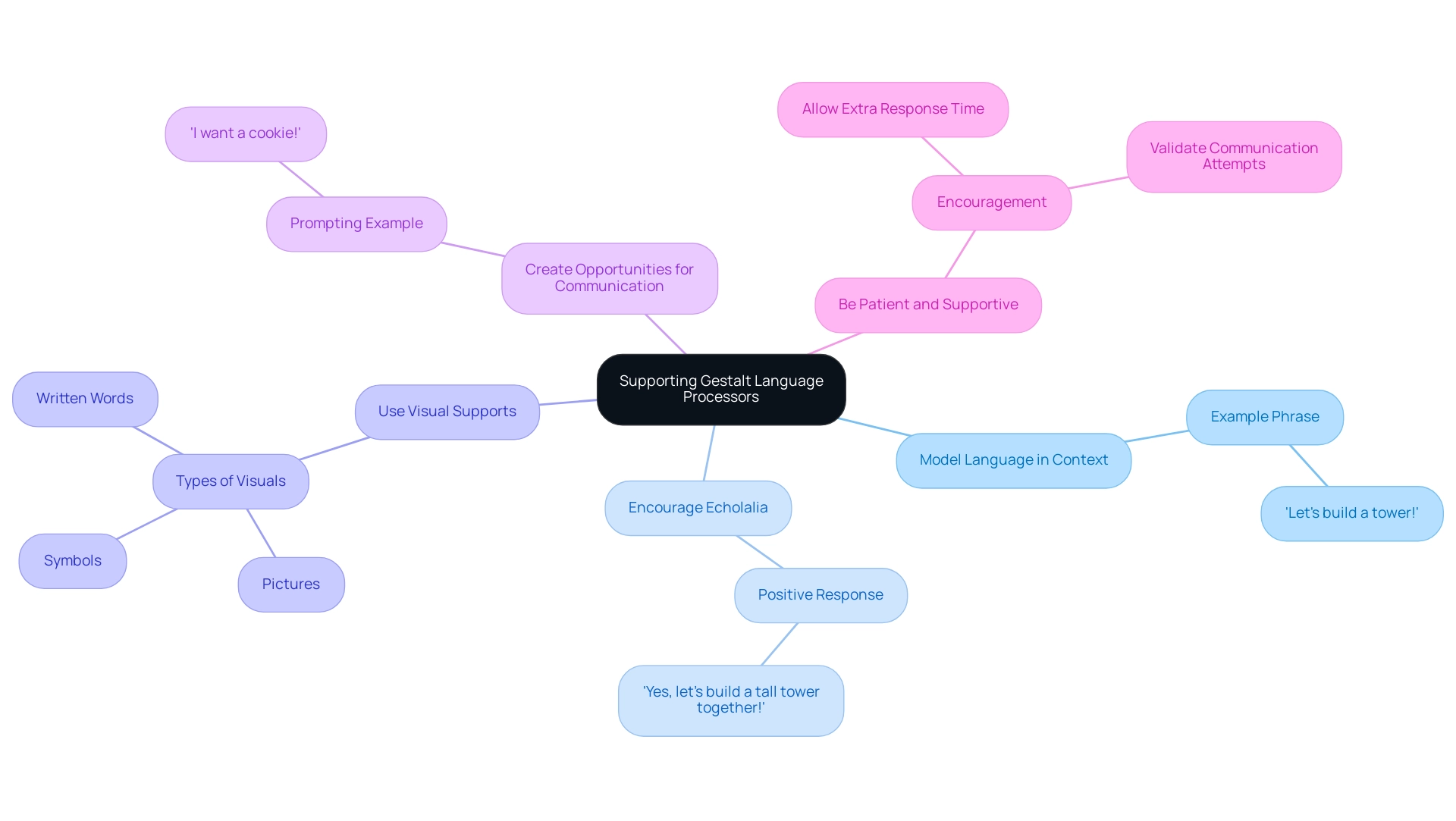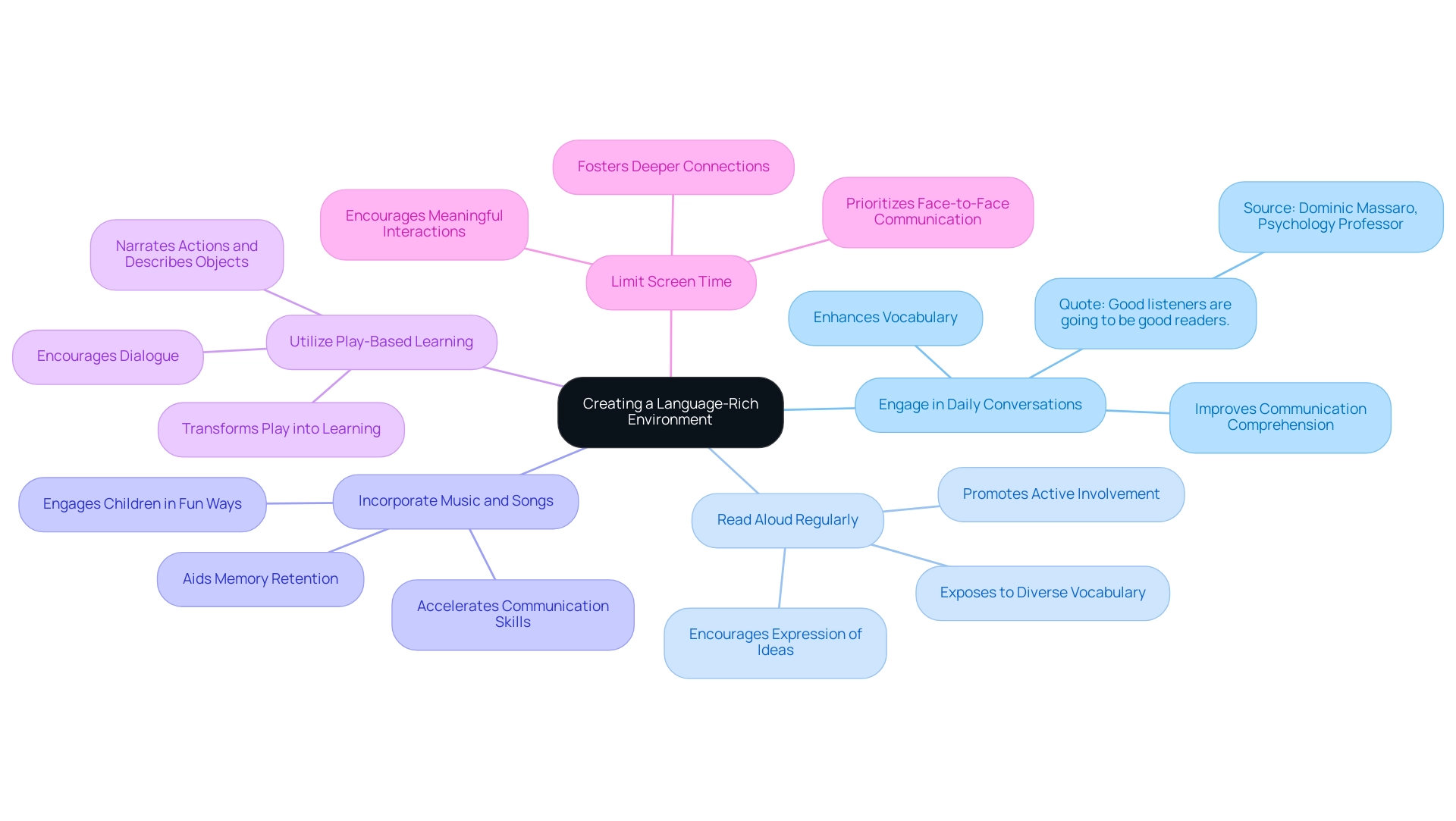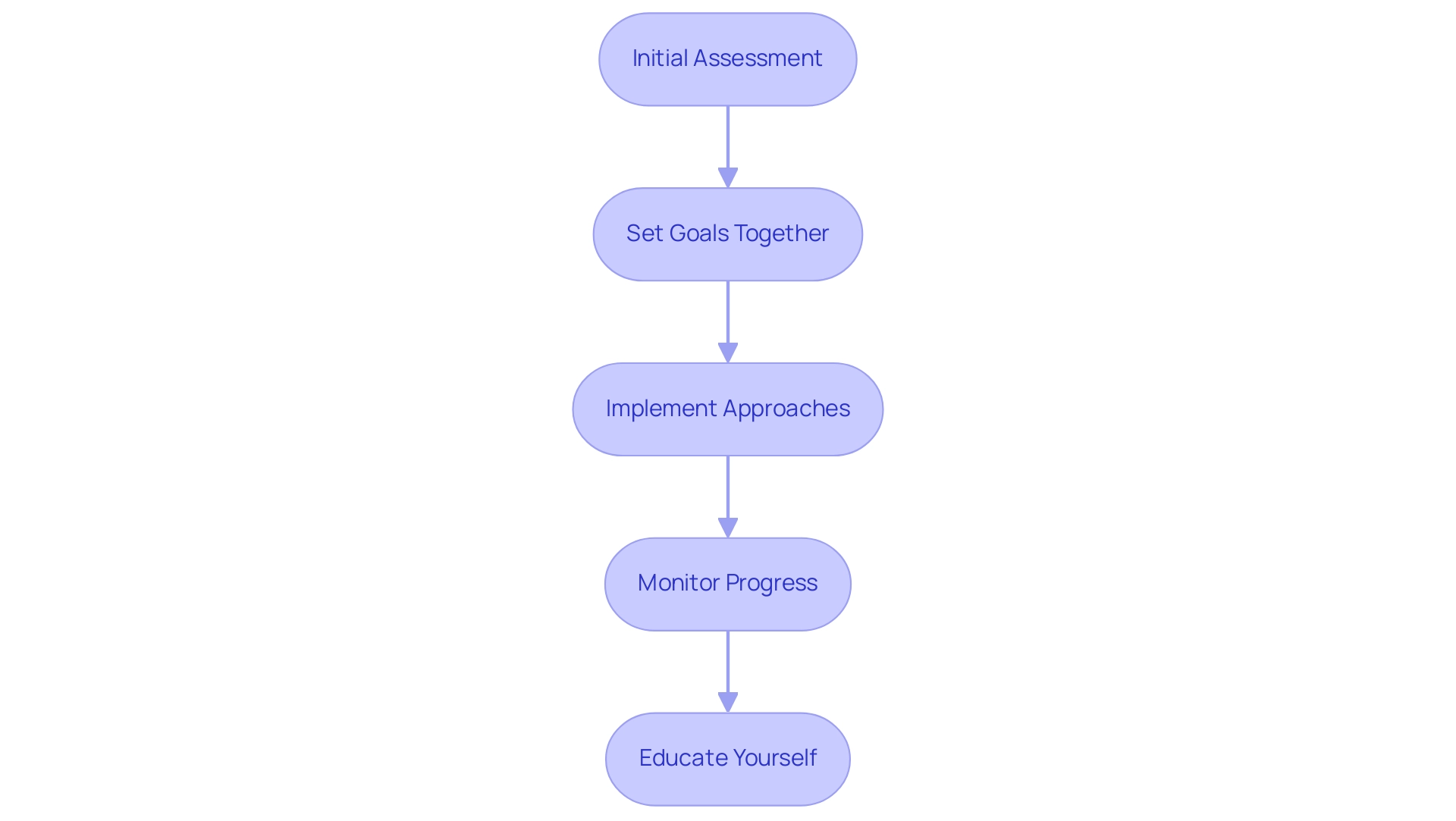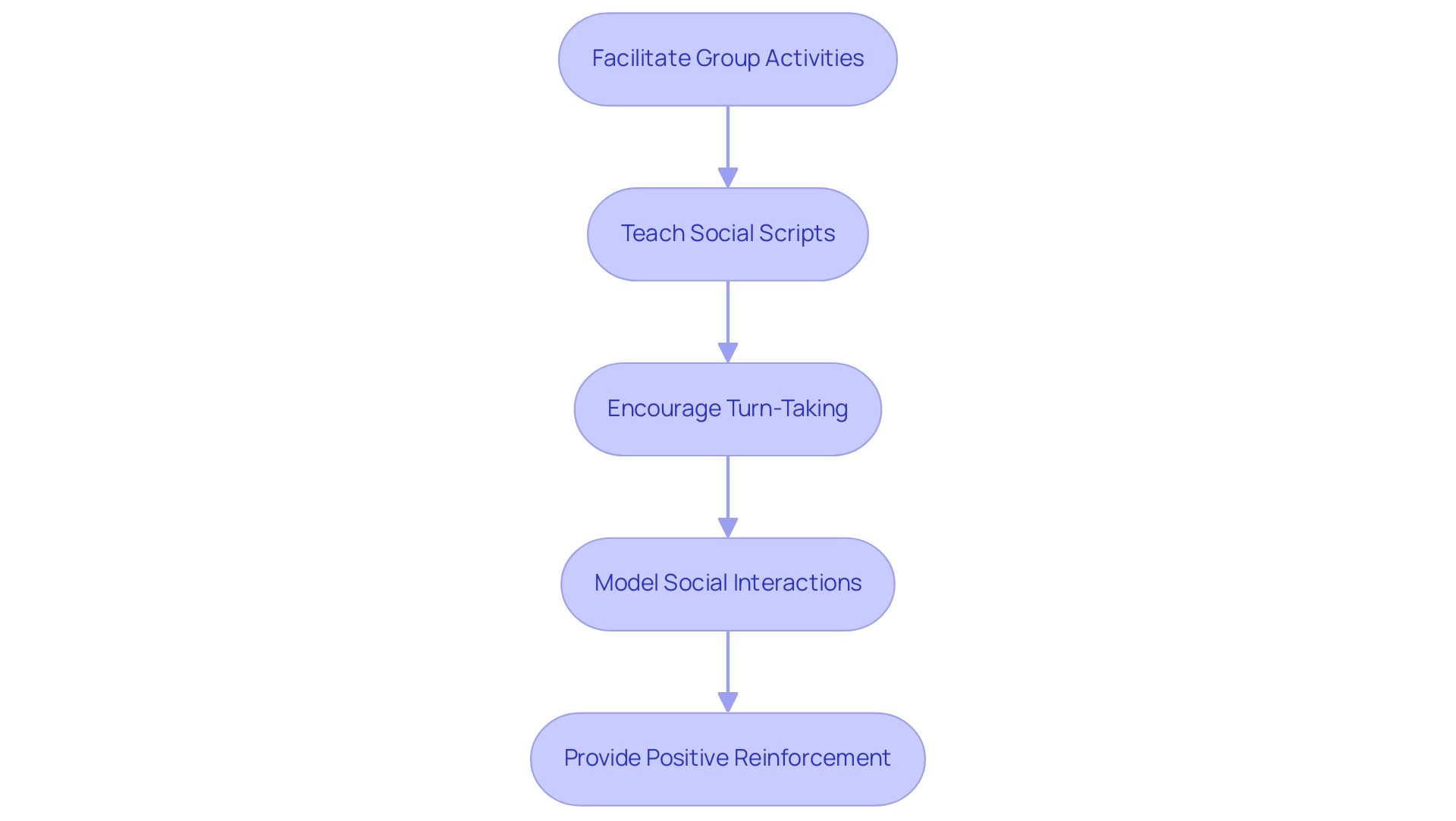Introduction
Understanding the intricacies of Gestalt Language Processing (GLP) is essential for parents, educators, and speech-language pathologists who support children navigating this unique approach to language acquisition. GLP is characterized by the use of memorized phrases or chunks of language, often drawn from various sources, as children begin their communication journey. This article delves into the foundational concepts of GLP, including:
It outlines practical strategies for fostering effective communication. By creating a language-rich environment and collaborating with professionals, caregivers can significantly enhance the language development of children with GLP, paving the way for their successful integration into social interactions and academic settings.
1. Understanding Gestalt Language Processing: Key Concepts and Definitions
Gestalt language processing represents a distinctive approach to acquiring communication observed in some youngsters, wherein expression is primarily conveyed through whole phrases or chunks instead of isolated words. These phrases are typically memorized from diverse sources, including literature, films, or everyday conversations. Recognizing
gestalt language processing involves understanding that young individuals may begin their communication journey by utilizing these larger units of expression, which can subsequently be deconstructed into smaller components as their linguistic capabilities mature.
The foundational concepts of GLP include:
-
Echolalia: This phenomenon involves the repetition of phrases or sentences that a child has heard, which can occur immediately after hearing or be delayed. Echolalia is a prevalent characteristic of gestalt language processing and serves as a crucial intermediary step toward more adaptable communication.
-
Chunking: This refers to the individual's ability to employ learned phrases as singular units of meaning, a skill that can ultimately pave the way for the formation of original sentences.
-
Communication Development Stages: Children engaged in gestalt language processing (GLP) typically navigate through defined stages, beginning with echolalic speech and gradually advancing toward more generative forms of expression.
Kanner's original description of autism highlighted the importance of attention to detail and the inability to experience wholes without full attention to constituent parts, which is crucial to understanding GLP. At the beginning of Stage 4, as stated by Marge Blanc, "we need to inventory all contractions, and practice freeing up each word as an independent agent" (Blanc, 2024, p. 27). This method is crucial for aiding young individuals' transition from echolalic speech to more adaptable communication.
Furthermore, the Natural Language Acquisition (NLA) framework provides a structured approach for speech-language pathologists to track and support communication development in individuals who utilize gestalt language processing. Understanding these ideas is crucial for both caregivers and teachers, as it guides their approaches in assisting youngsters with gestalt language processing during their communication development journeys.
2. Practical Strategies for Supporting Gestalt Language Processors in Everyday Communication
To effectively support youth with Gestalt Language Processing (GLP), consider the following practical strategies:
-
Model Language in Context: Utilize natural, meaningful phrases during everyday conversations. For instance, while engaged in play, you might say, 'Let's build a tower!' This method assists young individuals in acquiring communication skills within a familiar context, motivating them to adopt and utilize phrases they have encountered.
-
Encourage Echolalia: Acknowledge echolalic speech as an essential aspect of communication. Responding positively to echolalic phrases fosters engagement. For example, if a young one states, 'Do you want to build a tower?' affirm their question with, 'Yes, let’s build a tall tower together!' This validates their communication attempts and encourages interactive dialogue.
-
Use Visual Supports: Incorporate visual aids such as pictures, symbols, or written words to enhance comprehension and communication. These visuals act as essential tools in bridging the gap between echolalic expressions and personalized language use, thereby facilitating learning.
-
Create Opportunities for Communication: Design situations that encourage the young person to express themselves through learned phrases. For instance, during snack time, prompt them to articulate, 'I want a cookie!' This active participation in conversation reinforces their communicative skills and confidence.
-
Be Patient and Supportive: Recognize that individuals with GLP may require additional time to respond or may rely on memorized phrases. Patience and encouragement are essential in fostering their confidence and capacity to communicate successfully.
Considering the substantial caseloads of school speech-pathologists, it is vital to utilize these effective methods to assist gestalt communicators in group environments. Furthermore, the '
Weekend Words: First and Then Board' YouTube series provides useful suggestions for parents, illustrating essential communication techniques that can greatly improve interaction skills in kids. Additionally, parents ought to refrain from overlooking communication efforts, utilizing intricate expressions, and concentrating exclusively on instructing grammar or mistakes, as these habits can obstruct verbal development.
By applying these approaches, parents and educators can foster a nurturing atmosphere favorable to verbal growth in youngsters who are engaged in gestalt language processing. This approach not only encourages them to express themselves but also fosters meaningful engagement in conversations, as emphasized by Dr. Kristen Prater, who noted,
As a BCBA, I would love to share this resource with my families! Thank you so much for making it easy to understand.
3. Creating a Language-Rich Environment for Gestalt Language Processors
To cultivate an enriching language environment for children with Gestalt Language Processing, several effective strategies can be implemented:
-
Engage in Daily Conversations: Consistent dialogue with young ones about various topics, such as daily activities, feelings, and observations, is crucial. As Dominic Massaro, a Psychology Professor at the University of California, Santa Cruz, states, "Good listeners are going to be good readers." This regular exposure not only introduces new vocabulary but also provides context for its use, enhancing overall communication comprehension.
-
Read Aloud Regularly: Regularly reading aloud to young ones exposes them to diverse vocabulary and complex sentence structures. Choosing captivating tales motivates young ones to echo phrases and express their ideas, which promotes active involvement and a greater comprehension of the subject.
-
Incorporate Music and Songs: The repetitive nature of songs, combined with their rhythmic qualities, significantly aids memory and accelerates communication skills. Singing along to familiar melodies encourages children to engage with communication in a fun and memorable way.
-
Utilize Play-Based Learning: Play serves as an effective medium for communication development. During playtime, narrating actions, describing objects, and encouraging dialogue can transform the experience into an interactive learning opportunity, making communication acquisition enjoyable and intuitive.
-
Limit Screen Time: While certain educational programs can be beneficial, excessive screen time may hinder meaningful interactions. Prioritizing face-to-face communication fosters deeper connections and richer communication experiences.
Additionally, it is important to recognize the significant disparities in communication exposure that exist, as illustrated by the case study '
The 30 Million Word Gap.' Research by Betty Hart and Todd Risley revealed that youngsters from professional families heard 30 million more words by age 3 compared to those from welfare families. This gap in exposure to communication correlates with vocabulary growth and IQ scores, emphasizing the need for parents and educators to engage more verbally with their offspring.
In light of recent challenges faced by students due to the pandemic, which has led to uneven impacts on attendance and grades, fostering a language-rich environment has never been more critical. By deliberately fostering such an environment, parents and educators can significantly improve the language development of youngsters through gestalt language processing. This approach equips them with essential tools for effective self-expression, ultimately contributing to their overall communication skills.
4. Collaborating with Speech-Language Pathologists
Collaborating with a speech-language pathologist (SLP) is essential for providing comprehensive support to young individuals with gestalt language processing. The following steps outline effective strategies for collaboration:
-
Initial Assessment: It is vital to arrange a thorough evaluation with an SLP, who will assess the individual's communication abilities and determine their specific requirements.
This initial evaluation acts as a basis for creating a personalized intervention plan suited to the individual's unique circumstances.
-
Set Goals Together: Engaging in a collaborative process with the SLP to establish realistic and attainable communication goals is vital. These objectives should be personalized, taking into account the child's current abilities, potential for growth, and the insights gained from the initial assessment.
Research indicates that the number of years providing intervention for clients with speech disorders is significantly positively correlated with effective outcomes (r = .417, p < .001), emphasizing the importance of experienced guidance in goal-setting.
-
Implement Approaches: Actively collaborating with the SLP to apply recommended methods during daily interactions is essential. Consistency between home environments and therapy sessions strengthens learning and supports the individual's communication development.
This approach aligns with findings from recent literature indicating that effective interventions are most successful when parents are actively involved in the therapeutic process, addressing
perceived barriers and facilitators to parent involvement in NDIS-funded interventions.
-
Monitor Progress: Regularly reviewing the individual's progress with the SLP ensures that strategies remain effective and relevant. Adjustments to the intervention plan should be made as necessary to promote continual growth in communication skills, reflecting a responsive and dynamic approach to therapy.
-
Educate Yourself: It is beneficial for parents and educators to engage with resources provided by the SLP, such as workshops and educational materials. This ongoing education enhances understanding of gestalt language processing and equips caregivers with effective support strategies.
By fostering a strong collaboration with speech-language pathologists, parents and educators can ensure that individuals with gestalt language processing (GLP) receive the comprehensive support they need, tailored to their distinct language processing requirements. The iterative nature of collaboration, as emphasized by researchers Pawson and Tilley, who describe realist evaluation as a methodology investigating the causal link between interventions and outcomes, illustrates how such partnerships can improve the application of research into practice, ultimately benefiting youth in diverse contexts.
5. Encouraging Social Interaction and Peer Communication
To effectively encourage social interaction and enhance peer communication among children with Gestalt Language Processing (GLP), implement the following strategies:
-
Facilitate Group Activities: Organize structured group playdates or collaborative activities that promote peer engagement. Such environments promote chances for youngsters to engage and employ communication in significant contexts, enhancing their exposure to directed speech, which is essential for developing processing efficiency, as indicated by a correlation coefficient of 0.39.
-
Teach Social Scripts: Equip young individuals with specific phrases or social scripts to navigate various interactions, such as initiating greetings or expressing the desire to join a game. This preparatory approach can alleviate anxiety and promote active participation in social settings, further enhancing their communication acquisition.
-
Encourage Turn-Taking: Create opportunities for turn-taking during games or conversations. This practice not only enhances communication skills but also helps children understand the reciprocal nature of social exchanges, which is vital for effective interaction and vocabulary development.
-
Model Social Interactions: Serve as a role model by demonstrating appropriate social behaviors and language use. Children learn significantly through observation, making it essential to showcase effective communication strategies in real-time interactions, which aligns with the key point that increased exposure to child-directed speech sharpens lexical processing skills.
-
Provide Positive Reinforcement: Actively acknowledge and praise children’s attempts to communicate with their peers. By reinforcing their efforts, parents and educators can build confidence and encourage ongoing engagement in social situations.
As Adriana Weisleder observes, "Do differences in processing efficiency mediate the well-established relation between early communication experience and later vocabulary knowledge?" This question highlights the significance of the approaches discussed. Furthermore, research indicates that increased exposure to child-directed speech is crucial for sharpening infants' lexical processing skills, thereby benefiting vocabulary acquisition.
The
ineffectiveness of video and audio exposure for infants, as highlighted in a study, suggests that live social interaction is essential for communication development. By fostering these interactive strategies, parents and educators can significantly enhance the language capabilities of children through gestalt language processing, ultimately supporting their growth in communication competence.
Conclusion
Understanding Gestalt Language Processing (GLP) is crucial for fostering effective communication in children who utilize this unique approach to language acquisition. The key concepts of echolalia and chunking highlight the significance of memorized phrases in the early stages of language development. Recognizing these patterns enables parents, educators, and speech-language pathologists to implement tailored strategies that enhance language growth.
Creating a language-rich environment plays a pivotal role in supporting children with GLP. Daily conversations, reading aloud, and engaging in play-based learning are essential practices that promote vocabulary development and communication skills. Additionally, collaboration with speech-language pathologists ensures that children receive personalized support, enabling them to progress through the various stages of language acquisition effectively.
Encouraging social interaction is equally important in the development of communication competence. By facilitating group activities, teaching social scripts, and providing positive reinforcement, caregivers can help children navigate social situations and enhance their peer communication skills.
In conclusion, the journey of children with GLP requires a multifaceted approach that combines understanding, practical strategies, and collaborative support. By fostering an environment that prioritizes language exposure and social interaction, caregivers can significantly enhance the language development of these children, setting the stage for successful integration into academic and social settings.
